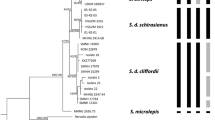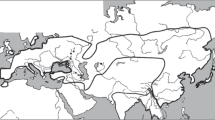Abstract
Paratelmatobius and Scythrophrys are leptodactylid frogs endemic to the Brazilian Atlantic forest and their close phylogenetic relationship was recently inferred in an analysis that included Paratelmatobius sp. and S. sawayae. To investigate the interspecific relationships among Paratelmatobius and Scythrophrys species, we analyzed a mitochondrial region (approximately 2.4 kb) that included the ribosomal genes 12S and 16S and the tRNAval in representatives of all known localities of these genera and in 54 other species. Maximum parsimony inferences were done using PAUP* and support for the clades was evaluated by bootstrapping. A cytogenetic analysis using Giemsa staining, C-banding and silver staining was also done for those populations of Paratelmatobius not included in previous cytogenetic studies of this genus in order to assess their karyotype differentiation. Our results suggested Paratelmatobius and Scythrophrys formed a clade strongly supported by bootstrapping, which corroborated their very close phylogenetic relationship. Among the Paratelmatobius species, two clades were identified and corroborated the groups P. mantiqueira and P. cardosoi previously proposed based on morphological characters. The karyotypes of Paratelmatobius sp. 2 and Paratelmatobius sp. 3 described here had diploid chromosome number 2n = 24 and showed many similarities with karyotypes of other Paratelmatobius representatives. The cytogenetic data and the phylogenetic analysis allowed the proposal/corroboration of several hypotheses for the karyotype differentiation within Paratelmatobius and Scythrophrys. Namely the telocentric pair No. 4 represented a synapomorphy of P. cardosoi and Paratelmatobius sp. 2, while chromosome pair No. 5 with interstitial C-bands could be interpreted as a synapomorphy of the P. cardosoi group. The NOR-bearing chromosome No. 10 in the karyotype of P. poecilogaster was considered homeologous to chromosome No. 10 in the karyotype of Scythrophrys sp., chromosome No. 9 in the karyotype of Paratelmatobius sp. 1, chromosome No. 8 in the karyotypes of Paratelmatobius sp. 2 and of Paratelmatobius sp. 3, and chromosome No. 7 in the karyotype of P. cardosoi. A hypothesis for the evolutionary divergence of these NOR-bearing chromosomes, which probably involved events like gain in heteochromatin, was proposed.







Similar content being viewed by others
References
Cochran DM (1938) Diagnoses of new frogs from Brazil. Proc Biol Soc Wash 51:41–42
Darst CR, Cannatella DC (2004) Novel relationships among hyloid frogs inferred from 12S and 16S mitochondrial DNA sequences. Mol Phylogenet Evol 31:462–475
Felsenstein J (1985) Confidence limits on phylogenies: an approach using the bootstrap. Evolution 39:783–791
Faivovich J, Haddad CFB, Garcia PCA, Frost DR, Campbell JA, Wheeler WC (2005) Systematic review of the frog family Hylidae, with special reference to Hylinae: a phylogenetic analysis and taxonomic revision. Bull Am Mus Nat Hist 294:1–240
Frost DR (2006) Amphibian species of the world: an online reference. V. 4 (17 August 2006). Electronic Database accessible at http://research.amnh.org/herpetology/amphibia/index.php. American Museum of Natural History, New York, USA
Frost DR, Grant T, Faivovich J, Bain RH, Haas A, Haddad CFB, de Sá RO, Channing A, Wilkinson M, Donnellan SC, Raxworthy CJ, Campbell JA, Blotto BL, Moler P, Drewes RC, Nussbaum RA, Lynch JD, Green DM, Wheeler WC (2006) The amphibian tree of life. Bull Am Mus Nat Hist 297:1–371
Garcia PCA (1996) Recaracterização de Scythrophrys sawayae (Cochran 1953) baseada em morfologia, osteologia e aspectos da miologia e história natural (Amphibia: Leptodactylidae). Master´s dissertation – PUCC RS, pp 1–78
Giaretta AA, Castanho LM (1990) Nova espécie de Paratelmatobius (Amphibia, Anura, Leptodactylidae) da Serra do Mar, Brasil. Pap Avul Zool, São Paulo 37:133–139
Goebel AM, Donnelly JM, Atz ME (1999) PCR primers and amplification methods for 12S ribosomal DNA, the control region, cytochrome oxidase I, and cytochrome b in bufonids and other frogs, and an overview of PCR primers which have amplied DNA in amphibians successfully. Mol Phylogenet Evol 11:163–199
Gonçalves, Martínez-Solano HI, Ferrand N, García-París M (2007) Conflicting phylogenetic signal of nuclear vs mitochondrial DNA markers in midwife toads (Anura, Discoglossidae, Alytes): Deep coalescence or ancestral hybridization? Mol Phylogenet Evol 44:494–500
Grant T, Frost DR, Caldwell JP, Gagliardo R, Haddad CFB, Kok PJR, Means DB, Noonan BP, Schargel WE, Wheeler WC (2006) Phylogenetic systematics of dart-poison frogs and their relatives (Amphibia: Athesphatanura: Dendrobatidae). Bull Am Mus Nat Hist 299:1–262
Heyer WR (1975) A preliminary analysis of the intergeneric relationships of the frog family Leptodactylidae. Smith Contr Zool 199:1–55
Heyer WR (1983) Variation and systematics of frogs of the genus Cycloramphus (Amphibia, Leptodactylidae). Arq Zool 30:235–339
Howell WM, Black DA (1980) Controlled silver staining of nucleolus organizer regions with a protective colloidal developer: a 1-step method. Experientia 36:1014–1015
King M (1980) C-banding studies on Australian hylid frogs: secondary constriction structure and the concept of euchromatin transformation. Chromosoma 80:191–217
Koblmüller S, Duftner N, Sefc KM, Aibara M, Stipacek M, Blanc M, Egger B, Sturmbauer C (2007) Reticulate phylogeny of gastropod-shell-breeding cichlids from Lake Tanganyika – the result of repeated introgressive hybridization. BMC Evol Biol 7:7 (doi:10.1186/1471-2148-7-7)
Lourenço LB, Garcia PCA, Recco-Pimentel SM (2000) Cytogenetics of two species of Paratelmatobius (Anura: Leptodactylidae), with phylogenetic comments. Hereditas 133:201–209
Lourenço LB, Garcia PCA, SM Recco-Pimentel (2003a) Intrageneric karyotypic divergence in Scythrophrys (Anura, Leptodactylidae) and new insights on the relationship with the leptodactylid Paratelmatobius. Ital J Zool 70:183–190
Lourenço LB, Garcia PCA, Recco-Pimentel SM (2003b) Cytogenetics of a new species of Paratelmatobius cardosoi group (Anura: Leptodactylidae), with the description of an apparent case of pericentric inversion. Amphibia-Reptilia 24:47–55
Lutz B, Carvalho AL (1958) Novos anfíbios anuros das serras costeiras do Brasil. Mem Inst Oswaldo Cruz 56:239–249
Lynch JD (1971) Evolutionary relationships, osteology, and zoogeography of leptodactyloid frogs. Univ Kans Mus Nat Hist, Misc Publ 53:1–238
Pombal Jr JP, Haddad CFB (1999) Frogs of the genus Paratelmatobius (Anura: Leptodactylidae) with descriptions of two new species. Copeia 1999:1014–1026
Ron SR, Santos JC, Cannatella DC (2006) Phylogeny of the túngara frog genus Engystomops (=Physalaemus pustulosus species group; Anura: Leptodactylidae). Mol Phylogenet Evol 39:392–403
Schmid M (1978) Chromosome banding in Amphibia. I. Constitutive heterochromatin and nucleolus organizer regions in Bufo and Hyla. Chromosoma 66:361–388
Schmid M, Olert J, Klett C (1979) Chromosome banding in Amphibia. III. Sex chromosomes in Triturus. Chromosoma 71:29–55
Swofford DL (2000) Phylogenetic analysis using parsimony, version 4.0b4a. Illinois Natural History Survey, Champaign
Acknowledgements
The authors thank Julián Faivovich, who generously provided some DNA sequences, Luís Olímpio, Luciano M. Castanho, and Marcos Yamamoto for help with the fieldwork, Klélia A. Carvalho for the tissue sample of Hylodes asper, and Paulo C. A. Garcia for valuable discussions. This work was supported by the Brazilian agencies Fundação de Amparo à Pesquisa do Estado de São Paulo (FAPESP), and Conselho Nacional de Desenvolvimento Científico e Tecnológico (CNPq).
Author information
Authors and Affiliations
Corresponding author
Rights and permissions
About this article
Cite this article
Lourenço, L.B., Bacci-Júnior, M., Martins, V.G. et al. Molecular phylogeny and karyotype differentiation in Paratelmatobius and Scythrophrys (Anura, Leptodactylidae). Genetica 132, 255–266 (2008). https://doi.org/10.1007/s10709-007-9169-y
Received:
Accepted:
Published:
Issue Date:
DOI: https://doi.org/10.1007/s10709-007-9169-y




